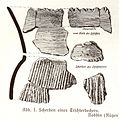Great stone grave Nobbin
The Nobbin Great Stone Grave (also called the Riesenberg Great Stone Grave) is a burial site of the Neolithic funnel cup culture in Nobbin , a district of the Putgarten municipality in the Vorpommern-Rügen district ( Mecklenburg-Western Pomerania ). It has the Sprockhoff number 466.
description
The megalithic complex built from boulders is one of the largest stone graves in northern Germany and is only a few meters from the steep coast of the "Tromper Wiek", directly on the high bank path.
It is a trapezoidal barn bed with two chambers ( extended dolmens ). The burial chambers have been disrupted more recently (1933 and 1970).
The trapezoidal edging of the complex, made up of 53 large curbs, is 34 m long and 11 to 8 meters wide (39 stones have been preserved). In the northwest there were two transverse dolmens , one of which is well preserved. It is 1.4 m high, 1.8 m long and 1.1 m wide. There are three bearing stones based on boulders and three more or less flat bearing stones, but no capstone. The access made of sheet material is designed coaxially in the form of a vestibule, as is typical for the Rügen large dolmen . The second dolmen was constructed in a similar way, but only one bearing stone is preserved.
- Nobbin giant mountain
On the south-west side, two guard stones set in front of the edging rise more than three meters as a pair of guardians from Nobbin , as they are also typical for Scandinavian dolmens , but also occur in a similar dimension in the Großdolmen of Dwasieden and Dummertevitz on Rügen. The furnishing with guard stones is rarer in Germany and is explained here by the proximity to the Danish islands.
The first excavation took place in 1932/1933 by Wilhelm Petzsch and Karl-August Wilde. She brought many finds. During excavations in 1970 by Ewald Schuldt , three cross-cutting arrowheads , a blade, a few shattered vessels and a few bone fragments (including two skulls) were found as Neolithic finds. In the northern burial chamber the remains of an urn burial from the 5th century BC were found. Found. Ceramic shards from the Slav period and an Arab silver coin from the 9th century came to light between the guard stones. This shows that the giant mountain was important for the islanders for millennia.
A second large stone grave has been reported, but the exact location is not known. It was suspected 250 meters north of the Altenkirchen-Putgarten road because the farmer had plowed out stone packs there, as was written during the excavation at grave 1.
- Finds from 1933
See also
- Nordic megalithic architecture
- Types of the Mecklenburg megalithic graves
- Guardian couple from Nobbin
literature
- Friedrich von Hagenow : Special chart of the island of Rügen. Designed according to the latest measurements using all existing land maps. Lithographic Institute of the General Staff, Berlin 1829.
- Lutz Mohr : The mysterious "Riesenberg" stone grave near Nobbin in the northeast of the island of Rügen. In: Stone Cross Research (SKF). Studies on German and international land monument research. Anthology No. 23 (NF 8), Regensburg 1996, pp. 79-81.
- Ingrid Schmidt: Hune grave and sacrificial stone - soil monuments on the island of Rügen . 1st edition. Hinstorff Verlag, Rostock 2001, ISBN 3-356-00917-6 , pp. 12-14.
- Ewald Schuldt : The giant mountain of Nobbin, Rügen district. - In: Bodendenkmalpflege in Mecklenburg, Yearbook 1971 (1972), 153-160.
- Ernst Sprockhoff : Atlas of the megalithic tombs of Germany. Part 2: Mecklenburg - Brandenburg - Pomerania. Rudolf Habelt Verlag, Bonn 1967, p. 63.
- Wilhelm Petzsch : Mannus - magazine for prehistory. Reprint, Verlag Kabitzsch, Leipzig 1933.
Web links
Coordinates: 54 ° 39 ′ 11 ″ N , 13 ° 23 ′ 36 ″ E









